|
May 10th, 2019 marked the 150th anniversary of the meeting of the Central Pacific and Union Pacific railroad lines in what was called the Transcontinental Railroad. This scene from the t.v. show Hell on Wheels recaps the end of the venture. Doc Durant delivers a compelling argument that the railroad could not have been built without the iron will and deceit of men like himself.
Are "truths delivered by lies no less true"? And are "dreams made reality by falsehoods no less real"? In this scene Doc Durant chastises the men in Congress who are now investigating him for his unsavory business tactics. He had a right to be indignant since the men investigating him were well aware he used bribery to get bills passed that favored and subsidized the building of the Transcontinental Railroad, lining the pockets of men like Durant and Collis P. Huntington of the Central Pacific Line. I was writing the Durant Family Saga when someone told me about Hell on Wheels. Colm Meaney does a great job reanacting Doc's blustery personality (although he looks nothing like the real Doc Durant). My saga begins where Hell on Wheels ends. The Durant Family Saga is a reunion of Doc Durant's family in the United States, after he had sent them to live abroad while he built the transcontinental. During the 1860s Durant had acquired over 1/2 million acres of wilderness in the Adirondacks and expected his son, William West, to help him develop a new transportation line that would cut through the forests and reach Canada. Along the way Doc expected he would make another fortune selling off and developing land for vacation homes and resorts. What Doc hadn't planned on was the financial panic of 1873 or the public, his business partners and stock owners turning against him. By the time his family appears on the scene in 1874, leaving behind their friends and family in England, Doc is financially bankrupt and his reputation in tatters. He had to contend with numerous lawsuits against him, a family that was not used to taking orders, and a son who had spent most of his life spending money rather than investing it. Beyond the business dealings, the Durant family life offered enough drama for me to write a trilogy. But the legacy of the Transcontinental never ends. Congress instructed special committees to investigate the business dealings of the two railroad empires and Durant and Huntington were hounded by the press. Durant died in 1885, never having to own up to his wrong-doings. Huntington's company however was fined by the government and he spent his last years constantly defending his reputation. He got his revenge though. Because soon after Doc Durant dies, Huntington takes Durant's son, William under his wing. This relationship proves unfortunate for the Durant family fortune. Huntington calculated revenge against his old rival and William was too naive to see this. William's hope to fulfill his father's ambition to develop the wilderness was financed with money borrowed from Huntington. In the end, Doc Durant was right, his dreams, made reality, were based on falsehoods.
5 Comments
4/23/2019 We Are All Made of StoriesWhile visiting my aging parents recently I attended a social gathering of their friends and neighbors. A man I was conversing with told me about his work at Eastman Kodak before its slow dissolution. When I mentioned I was an author of historical fiction and thought the history of the Kodak Company might make a good non-fiction book, he proceeded to tell me that more importantly, he wanted someone to write about the Hungarian revolt against the Soviet Union in 1956. He was part of the revolt as a teen. But he had to flee along with 200,000 other refugees, when the revolt was violently crushed by the Soviets after only 12 days. The ghost writer he had hired to write his memoir died and the idea that his story would never be written nor published was weighing on him.
This man had a best friend-a fellow comrade aged 16 who was captured by the Soviets. The Soviet's had a law that made it illegal to put someone under 18 to death, so they held his friend in prison until he turned 18 and then executed him. My mother told me that as she ages she has been having flashbacks-vivid memories of her childhood that she had long forgotten. If this is so for most people as they age (and I have no idea if it is) then I suppose for this man, his visions of the tumultuous 12 days and loss of his best friend must be haunting him. He spent the better part of an hour discussing it with me. He told me not many people know about this time in history (it was only 12 days but had greater ramifications for the U.S./Soviet relationship.) He told me the citizens of Hungary were the only ones that revolted against the Soviets although so many in the Union despised the oppression. He eyes were filled with loathing. I've met numerous writers at conferences who are there to learn how to publish a memoir. I wish my life was that interesting. Although I've used vignettes from my personal experience or people I've known for my fiction (specifically in Ephemeral Summer I wrote a scene where the main characters are tracking moose in Algonquin Provincial Forest for scientific research, something I did in graduate school), my fiction is mainly about other people's lives. Just recently I picked up a book titled: Ithaca Diaries, written by Anita Harris about her days as a college student at Cornell University in the late 1960s early 1970s. How brave to write about coming of age during the race and anti-Vietnam War riots taking place on campus. Personally, I'd rather write a fictionalized version of someone else's past. But I have a high regard for writers who feel they have an important story to tell: their own. 3/10/2019 This Too Shall Pass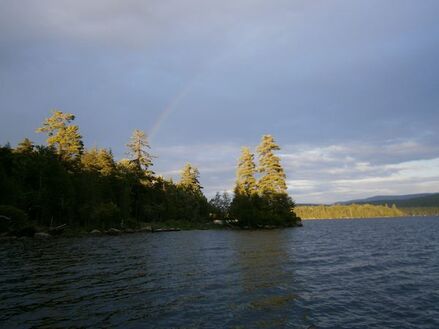 A friend--photographer--told me he didn't like to take pictures of raibows, they were too ephemeral he said, not meant to be photographed. I happened to catch this one over the point by Silver Beach on Raquette Lake while sitting on the porch of a cabin I rented. It's faint, but we all know what it feels like to see a rainbow in the sky. Even though it's fleeting, we just sit and stare until it goes away, hoping to hang onto that magical feeling it brings for as long as we can. Maybe that's why photographers chase rainbows, sunsets, full moons, shadows in the woods. Why artists paint capture scenes and authors write about them. These moments are why people create; to make something last, a feeling, an experience, a moment in time. 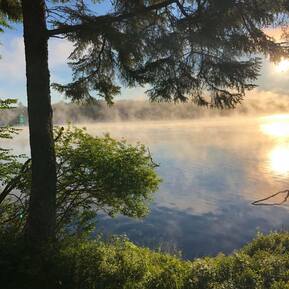 There's a poem called This Too Shall Pass Away, written by Ella Wheeler Wilcox 1900 which refers to a story about an ancient King who asks his sages to find words of wisdom that would guide him. One of them brought back a ring with the saying 'this too shall pass' inscribed inside (or so various versions of the story go). The meaning, that all things are temporary, much like the rainbow, is hard to swallow. How can this moment of joy be taken away? Yet, the same goes for those times of sorrow. It is only temporary. If only we could remember this when things seem so bleak. As I work on my novel about the Durant family I realize this may be what they were striving for, to leave a legacy, even if it wasn't in the form of wealth. The Durant's were creators. William built Great Camps in the Adirondacks, that would withstand the elements of the Northern Woods. Ella Durant published her poetry. Their father, Dr. T.C. Durant built railroads across the country. I see how all of it, the hard work, the drive to perfection, to discover more about how to turn a vision into reality - all of it - is an attempt to fight that adage that this too shall pass. Maybe, what drives the creator of such works, is an attempt, like Ozymandias, to leave a behind a legacy that fights back at time. Maybe that's why I write. 1/8/2019 Preserving Public History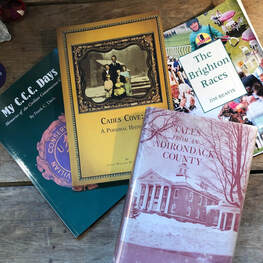 This is an ode to those public historians who went out of their way to write and publish local history that would otherwise have been forgotten. Whether it was about their own past experience, or the history of a place, these books are gems for those of us writing historical fiction. They are accounts of the ordinary people, ones who may not have been famous, but whose lives are the fabric of the past. I've found my share of these treasures while researching my novels. 12/18/2018 Women Authors Are Not a Trend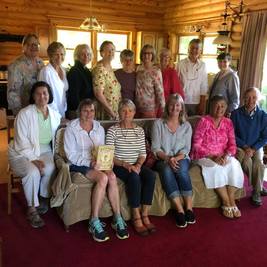 My visit with Ladies of the Lake Book Club Raquette Lake NY. My visit with Ladies of the Lake Book Club Raquette Lake NY. While attending a writers conference recently the speaker, a literary agent, was asked what he viewed as a trend in the industry. His answer was publishers were looking for women who write about women. He predicted, like most trends, this was fleeting and would either end or balance out. I began to wonder if what he deems a trend is really just an adjustment in a long history of marginalization of women authors. Just cursory research shows women authors have been under-represented for awards. Since 1901, the Nobel Prize for Literature has only been awarded to 14 women. There have only been 35 women winners of the Pulitzer Prize for fiction since it was first awarded in 1917. While disconcerting, it also doesn't match up with the trends in women readership. I was intrigued by all of this because I've been in a book club for over 15 years. As an author I've been invited to speak with several book clubs. All organized and attended by women. Just recently, I spoke to my largest audience ever - 140 ladies in Charlotte, NC - who call themselves the JULIETS (Just us ladies interested in learning, eating, talking and sharing). And as an author, I've been privileged to be able to network with other women authors in such online forums and memberships groups as the Women Fiction Writers Association and Women Writers Women's Books. Both organizations have a strong following. They offer guidance, mentoring, educational and promotional opportunities for women from diverse backgrounds. 12/6/2018 Writing Alone In the Wilderness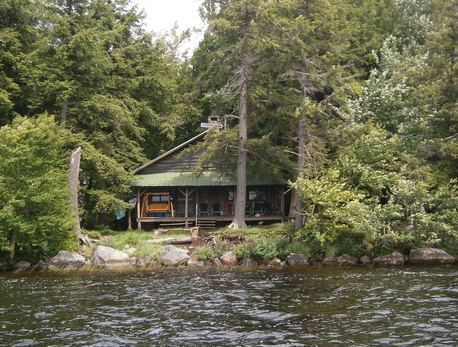 It sounded like a good idea at the time: a week at a cabin built in 1890 on Raquette Lake, NY. The perimeter of the lake is 95% public land, part of the Adirondack Park wilderness and the cabin is part of a compound owned by a state college. It has no electricity, no wi-fi, no cell phone coverage, and is only accessible by foot or boat. It would be idyllic, a haven of peace away from the tumultuous clamor of modern life. A place to write my novel. 11/15/2018 The First Snow in the Finger Lakes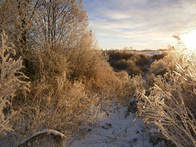 Here in the Finger Lakes we were 'blessed' with an early snow storm. A few years back I took these pictures when in November, we got a dusting. When it snows here, the skies are gloomy, filled with moisture. I was having a hard time getting just the right shots. For three days in a row during the Thanksgiving break I woke each morning at the required time for this season of the year (7 am) and it was always overcast. One morning I got lucky enough to capture the sun rising in the gloom, and paid for it with a nasty fall on the ice as I took a picture from the boat launch. Then it happened. The perfect-picture-taking-dawn. I arose at 7 am and the sun was rising with just wisps of clouds in the sky, and magically, it had also snowed overnight. I grabbed my coffee, my camera and my boots and waded through the newly fallen snow in the farms fields at the end of my road. And I was rewarded with crystal images. So, it was worth it - waiting - for the right moment in time to take the pictures that would capture the beauty of this landscape that I live in; that shows itself when it wants, not when you need it to. A lesson well worth remembering when days get shorter and the darkness sets in. A lesson to keep in mind in general. 11/15/2018 Ephemeral Summers in the Finger Lakes A few years ago I spent my ephemeral summer writing my first novel. There is nothing like the feeling of accomplishing something; especially when it is a labor of love. That is how I feel about my novel Ephemeral Summer. So I was especially pleased when I recently received an email from a women's book club in Twin Cities of Minnesota who are coming to the Finger Lakes region and want to meet and speak with me about my novel. Ephemeral Summer is a coming of age story about a young woman named Emalee who loses both parents die when she is 15. After the tragedy she is sent to live with her Aunt Audrey who summers at the family camp on Canandaigua Lake in Upstate New York. Emalee is beset with the usual problems of a young woman, but her familial relationships and 'lake friends' make her life even more trying. In her twentieth year she falls in love with a young intellectual philosopher named Stuart, whom she can't seem to get over even after years away from him and the lake setting where they met. Although a love story, Ephemeral Summer weaves in a sense of place, the wonders of the environments Emalee inhabits. Starting and ending in the Finger Lakes region, this story takes the reader from the shores of Canandaigua, Seneca, and Lake Erie, to the Canadian wilderness where Emalee finds herself tracking Moose as part of a research project in Algonquin Provincial Park. I wrote and edited this book (with the help of many people) over the course of a few years. My purpose was to educate about this great place - the Finger Lakes - where I live in an entertaining fashion. I hope I've accomplished this and hope you'll enjoy read Ephemeral Summer. 11/14/2018 Tracking Stories in the Algonquin Wilderness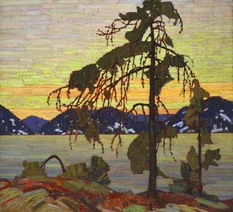 Jack Pine by Tom Thomson Source: Wikimedia Jack Pine by Tom Thomson Source: Wikimedia Writing placed-based literature is a great experience because there are always stories embedded in the culture of an area that a writer can use as a springboard. When I wrote Ephemeral Summer I placed my college-age protagonist, Emalee, in settings that were familiar to me. She attends college in the Finger Lakes region of Upstate New York because I know the area well. However, like most college-age students she moves around, and in the last chapter, she visits the Canadian wilderness to assist a fellow graduate student track moose in Algonquin Provincial Park in Canada. Although I had stayed in Algonquin twice myself during graduate school (tracking moose), my research on Algonquin went beyond the ecological setting and into the realm of art. While conducting my research I was surfing the Internet for information about the Northern Lights to include in the novel, and stumbled upon the artwork of Tom Thomson, (1877-1917) an artist from the early 1900s who painted landscapes in Algonquin. Thomson first visited Algonquin in 1912 and fell in love with the place. He stayed, found jobs as a ranger, firefighter and any other occupation that the woods would allow, and painted in his spare time. His paintings are considered the forerunner of a movement of painters called The Group of Seven: a group of Canadian landscape painters who spent considerable time painting in Algonquin from the 1920s-1930s. As I delved into his story I found parallels to my plot. There is an accidental death by drowning in my story Ephemeral Summer, and Thomson likewise drowned under mysterious circumstances. In 1917, at age 40, he went out canoeing and was found dead a week later. Foul play was suspected but never confirmed. Like many artists, Thomson did not make a lot of money on his works. Although he did have a patron, and some of his works sold, he became more popular after his death. And that is what is most intriguing about Thomson: his drive to create art whether it sold or not. His story folded neatly into my narrative for Ephemeral Summer. Indeed, for many artists, who create for art's sake, because they feel compelled.  I launched a project to fund my research on a historical novel with a crowdfunding site and it failed. Specifically, what lured me into trying crowdfunding on the site I chose was a podcast interview with one of the founders where she stated that artists are finding backers for their creative projects on their platform, and that 60% of the backers come from within the crowdfunding community itself. Hence, with the thought that I might find a community of like-minded artists, trying to fund projects, who would back the research for my next novel, I gave it a try. Nothing is failure if it is a learning experience and hopefully you can take away some tidbits of advice before you spend a lot of time and effort on your own crowdfunding campaign. I’ll start with the positive aspects of my experience.
Now the Negatives: |
AuthorSheila Myers is an award winning author and Professor at a small college in Upstate NY. She enjoys writing, swimming in lakes, and walking in nature. Not always in that order. Archives
March 2023
CategoriesAll Adirondacks Algonquin Appalachia Award Canada Chestnut Trees Christmas Civilian Conservation Corps Collis P. Huntington Creativity Doc Durant Durant Family Saga Emma Bell Miles Finger Lakes Great Depression Hell On Wheels Historical Fiction History Horace Kephart Imagination National Parks Nature Publishing Review Screenplay Short Story Smoky Mountains Snow Storm Stone Canoe Literary Magazine Thomas Durant Timber Wilderness World War II Writing |
|
|
All materials Copyright 2022
Any reproduction, reprint or publication without written consent of author prohibited. |
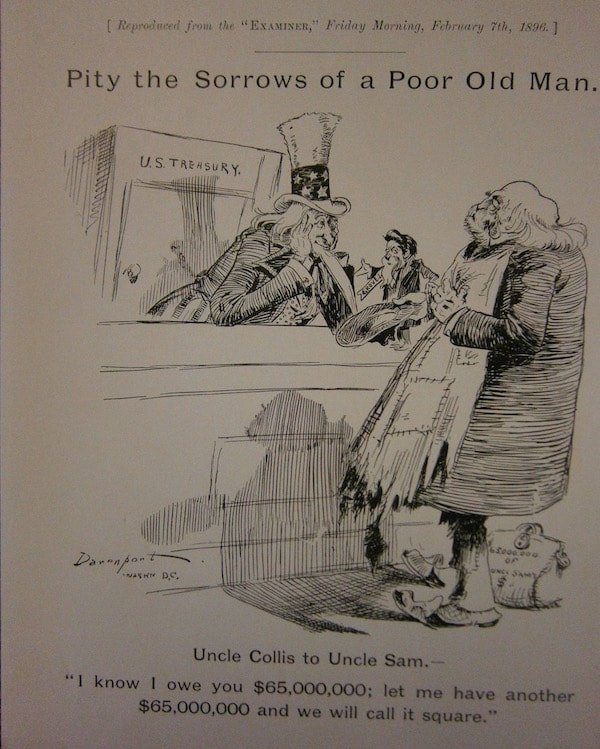

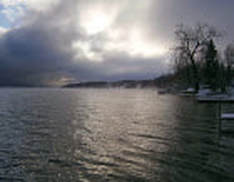
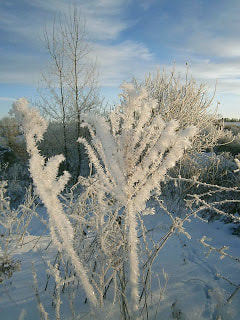
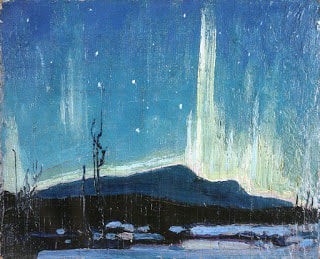
 RSS Feed
RSS Feed